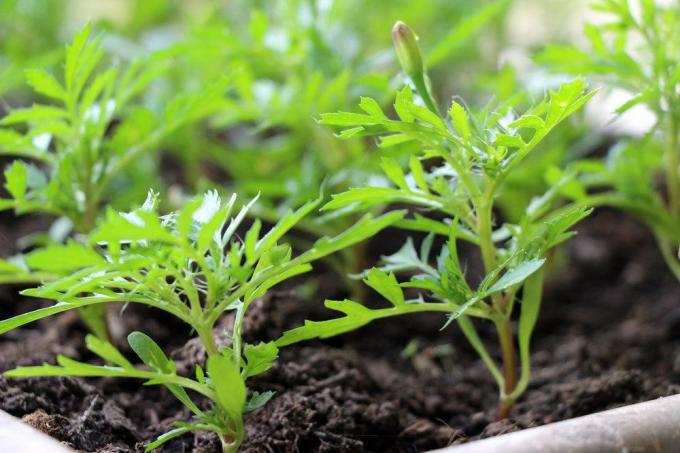
table of contents
- Extraction of the seeds
- Time of sowing
- The right substrate
- Seeding procedure
- Proceed further
- Plant out the marigold
the Tagetes, also called marigold, is one of the most popular perennials in the garden bed and also fills the balcony with color. In addition to its appearance, the flower has other noteworthy properties such as protection against snails or the improvement of soil conditions. So it is definitely worthwhile to multiply them by sowing them. Fortunately, planting out is very easy. In any case, the marigold bloom appears most beautiful when it appears in a lush sea of flowers.
Extraction of the seeds
Those who do not yet have a marigold can get the seeds from specialist shops. Otherwise, the gardener will harvest the seeds after they have withered in autumn. It is located in small tubes that are clearly visible after the tagetes have bloomed. The gardener carefully removes the seed heads with tweezers and keeps them in a paper bag until the appropriate time for sowing in spring.
Note: In order to be able to sow the seeds of the marigolds again in the following year, it is important not to completely remove the withered flowers in late summer.
Time of sowing
Unfortunately, the perennials are very sensitive to cold, which is why direct sowing outdoors is only recommended in mild regions. Here, too, the gardener should wait for the night frosts to subside after the ice saints. It is better to grow them on the windowsill, which is possible as early as March. Since it is a relatively undemanding plant, even beginners can grow it.
The right substrate
The marigold needs nutrient-poor soil. For example, unfertilized coconut fibers or special potting soil from specialist retailers are suitable.
Note: Conventional potting soil provides too many nutrients for the young shoots. Thus the marigold grows unnaturally fast. There is an imbalance between stem and flower, so that the plants bend with increasing height.
Seeding procedure
- Fill the substrate into the growing pots
- Press the earth lightly
- Sprinkle seeds on the surface
- the marigold is a light germ, therefore hardly or only very little cover with soil
- dust carefully with moisture (spray bottle) so as not to wash away the seeds
- Put a transparent plastic bag over the pot
- Ventilate several hours a day to prevent mold
- Water the substrate regularly
- the first shoots appear after one to two weeks

Proceed further
After sowing, the young shoots feel comfortable in a bright, but not full sun, location. A windowsill is ideal. The optimal temperature for germination is 18 ° C to 20 ° C. If two or three pairs of leaves have formed, it is necessary to prick out the young plants. Since the gardener initially sows the marigolds in small groups, the roots compete for space in the nursery pot with increasing size. When pricking the gardener proceeds as follows:
- Prepare growing pots again
- use potting soil mixed with sand
- Moisten the substrate slightly
- Use a pricking stick to drill small holes in the earth
- Carefully free the shoots from the earth with the pricking stick
- put in the new flower pots
- Carefully press the substrate
- moisten with spray bottle
Note: Before planting out, it is advisable to get the young plants used to the fresh air and the sun. To do this, the gardener places them in a bright place on the terrace during the day. But at night he has to bring the pots back into the house.
Plant out the marigold
If night frosts are no longer to be expected, the gardener can put his self-grown Tagetes outdoors. After the germination and growth phase, the marigolds can now also tolerate full sun. This is where they even feel most comfortable, even if they tolerate partially shaded locations.



